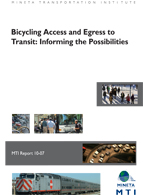- 408-924-7560
- mineta-institute@sjsu.edu
- Donate
Bicycling Access and Egress to Transit: Informing the Possibilities
When effectively integrated with transit services, considerable room exists for bicycling to realize various benefits to communities. A successful marriage between bicycling and transit will likely increase the use and efficiency of both modes. A core problem, however, exists in that the predominant approach for integrating bicycles and transit—bicycles aboard transit vehicles—frequently runs up against capacity restraints. Integrating bicycling and transit requires analysis of a broad range of alternatives that considers both the travel patterns and needs of individuals but also accompanying urban form characteristics. What are the most cost effective strategies likely to generate the largest number of cyclists accessing transit?
To aid in developing a framework to evaluate the cost effectiveness of different strategies to integrate transit and bicycling this project: (1) reviews the state of the knowledge, (2) proposes an analysis framework for communities and transit agencies to consider in efforts to maximize the integration of bicycling and transit, (3) conducts focus groups with cyclists from five case study communities to gauge preferences for bicycle and transit integration strategies, and (4) develops a preliminary application to evaluate four bicycle and transit integration strategies based on focus group discussions and use of the Analytic Hierarchy Process (AHP). These evaluation measures are applied to five communities.
A CTU index provides an initial attempt to understand transit stops that have a higher likelihood to attract CTUs. The Analytic Hierarchy Process ranked cyclists’ preferences for four bicycle and transit integration strategies in order of preference: (1) “Bike ON transit” (transporting the owner’s bicycle aboard( inside or outside) the transit vehicle) (0.471), (2) “Bike TO transit” (using and parking the owner’s bicycle at a transit access location) (0.185), (3) “Shared bike” (sharing a bicycle, which would be based at either the transit access or egress point) (0.185), and (4) “Two bike” (using an owner’s two bicycles at the access and egress location) (0.159). Results of the cost effectiveness assessment suggest that “Bike ON transit” ranked most cost effective overall, followed by “Bike to transit,” “Two bike,” and “Shared bike” strategies.
KEVIN KRIZEK, PhD
Kevin J. Krizek is an associate professor of Planning, Design, and Civil Engineering at the University of Colorado. He serves as director of the PhD program in Design and Planning and heads the Active Communities/Transportation (ACT) Research Group. His research focuses on travel behavior (specializing in cycling), neighborhood accessibility, health and planning, and sustainable development. Krizek is a founding editor of the Journal of Transport and Land Use, serves as chair of the Transportation Research Board Committee on Telecommunications and Travel, and is on the editorial board of the Journal of the American Planning Association. For more information, see www.kevinjkrizek.org.
ERIC STONEBRAKER, MS
Eric W. Stonebraker is a doctoral student in the College of Architecture and Planning at the University of Colorado. He is a National Science Foundation (NSF) fellow in the Integrative Graduate Education and Research Traineeship (IGERT) program focused on sustainable urban infrastructure. His research interests focus on travel behavior and the built environment.
SETH TRIBBEY
Seth Tribbey is a graduate student and GIS professional pursuing a dual degree in urban and regional planning and business administration from the Urban and Regional Planning Program at the University of Colorado Denver.
-
Contact Us
San José State University One Washington Square, San Jose, CA 95192 Phone: 408-924-7560 Email: mineta-institute@sjsu.edu






